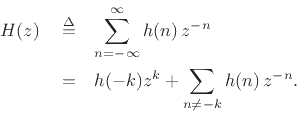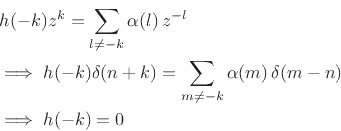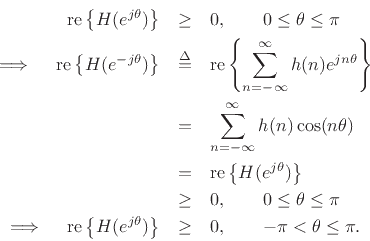Any passive driving-point impedance, such as the impedance of a
violin bridge, is positive real. Positive real functions have
been studied extensively in the continuous-time case in the context of
network synthesis [68,528]. Very little, however, seems
to be available in the discrete time case. This section (reprinted
from [432]) summarizes the main properties of positive real
function in the ![]() plane (i.e., the discrete-time case).
plane (i.e., the discrete-time case).
Definition.
A complex valued function of a complex variable ![]() is said to be
positive real (PR) if
is said to be
positive real (PR) if
We now specialize to the subset of functions
![]() representable as a ratio of finite-order polynomials in
representable as a ratio of finite-order polynomials in ![]() ,
, ![]() and
and ![]() . Such ``rational functions'' are meromorphic,
meaning that they are analytic for all
. Such ``rational functions'' are meromorphic,
meaning that they are analytic for all ![]() except at a set of isolated
points given by the zeros of the denominator polynomial
except at a set of isolated
points given by the zeros of the denominator polynomial ![]() . This
class of meromorphic functions represents all filter transfer
functions for finite-order, time-invariant, linear systems, and we
write
. This
class of meromorphic functions represents all filter transfer
functions for finite-order, time-invariant, linear systems, and we
write ![]() to denote a member of this class. We use the convention
that stable, minimum phase systems are analytic and nonzero in
the strict outer disk
to denote a member of this class. We use the convention
that stable, minimum phase systems are analytic and nonzero in
the strict outer disk ![]() . Condition (1) implies that for
. Condition (1) implies that for
![]() to be PR, the polynomial coefficients must be real, and
therefore complex poles and zeros must exist in conjugate pairs. We
assume from this point forward that
to be PR, the polynomial coefficients must be real, and
therefore complex poles and zeros must exist in conjugate pairs. We
assume from this point forward that
![]() satisfies (1). From
(2) we derive the facts below.
satisfies (1). From
(2) we derive the facts below.
Property 1. A real rational function ![]() is PR iff
is PR iff
![]() .
.
Proof. Expressing ![]() in polar form gives
in polar form gives

Since the zeros of ![]() are isolated (because
are isolated (because ![]() is analytic for
is analytic for
![]() ), the phase
), the phase
![]() is unrestricted only at
isolated points (the zeros of
is unrestricted only at
isolated points (the zeros of ![]() ). We may define the phase
arbitrarily when
). We may define the phase
arbitrarily when ![]() , and the most natural definition is its
limit as
, and the most natural definition is its
limit as ![]() approaches the zero; such a definition satisfies the
constraint
approaches the zero; such a definition satisfies the
constraint
![]() because every point in any
valid limiting sequence satisfies the constraint, and the domain of
the constraint is closed (the image of a continuous function of
a compact set is compact--if
because every point in any
valid limiting sequence satisfies the constraint, and the domain of
the constraint is closed (the image of a continuous function of
a compact set is compact--if ![]() were replaced by
were replaced by ![]() , we
could have a problem.) Therefore, we may conclude that
, we
could have a problem.) Therefore, we may conclude that
![]() for all
for all
![]() , not just
where
, not just
where ![]() is nonzero.
is nonzero.
![]()
Property 2. ![]() is PR iff
is PR iff ![]() is PR.
is PR.
Proof. Assuming ![]() is PR, we have by Property 1,
is PR, we have by Property 1,
Property 3. A PR function ![]() is analytic and nonzero in
the strict outer disk.
is analytic and nonzero in
the strict outer disk.
Proof. (By contradiction)
Without loss of generality, we treat only ![]() order polynomials
order polynomials
which are nondegenerate in the sense that
The general (normalized) causal, finite-order, linear,
time-invariant transfer function may be written

Suppose there is a pole of multiplicity ![]() outside the unit circle.
Without loss of generality, we may set
outside the unit circle.
Without loss of generality, we may set ![]() , and
, and
![]() with
with ![]() . Then for
. Then for ![]() near
near ![]() , we have
, we have

Consider the circular neighborhood of radius ![]() described by
described by
![]() . Since
. Since ![]() we may
choose
we may
choose
![]() so that all points
so that all points ![]() in this neighborhood lie
outside the unit circle. If we write the residue of the factor
in this neighborhood lie
outside the unit circle. If we write the residue of the factor
![]() in polar form as
in polar form as
![]() , then we have,
for sufficiently small
, then we have,
for sufficiently small ![]() ,
,
which cannot be confined to satisfy Property 1 regardless of the value of the residue angle
Corollary. In equation Eq.(C.80), ![]() .
.
Proof. If ![]() , then there are
, then there are ![]() poles at
infinity. As
poles at
infinity. As
![]() ,
,
![]() , we must have
, we must have ![]() .
.
![]()
Corollary. The log-magnitude of a PR function has zero mean on the unit circle.
This is a general property of stable, minimum-phase transfer functions which follows immediately from the argument principle [299,329].
Corollary. A rational PR function has an equal number of poles and zeros all of which are in the unit disk.
This really a convention for numbering poles and zeros. In Eq.(C.80),
we have ![]() , and all poles and zeros inside the unit disk. Now, if
, and all poles and zeros inside the unit disk. Now, if
![]() then we have
then we have ![]() extra poles at
extra poles at ![]() induced by the numerator.
If
induced by the numerator.
If ![]() , then
, then ![]() zeros at the origin appear from the denominator.
zeros at the origin appear from the denominator.
Corollary. Every pole on the unit circle of a positive real function must be simple with a real and positive residue.
Proof.
We repeat the previous argument using a semicircular neighborhood of
radius ![]() about the point
about the point
![]() to obtain
to obtain
Corollary.
If ![]() is PR with a zero at
is PR with a zero at
![]() , then
, then

must satisfy

Proof. We may repeat the above for ![]() .
.
Property. Every PR function ![]() has a causal inverse z transform
has a causal inverse z transform ![]() .
.
Proof. This follows immediately from analyticity in the outer disk
[345, pp. 30-36]
However, we may give a more concrete proof as follows.
Suppose ![]() is non-causal. Then there exists
is non-causal. Then there exists
![]() such that
such that
![]() .
We have,
.
We have,

Hence, ![]() has at least one pole at infinity and cannot be PR by Property 3.
Note that this pole at infinity cannot be cancelled since otherwise
has at least one pole at infinity and cannot be PR by Property 3.
Note that this pole at infinity cannot be cancelled since otherwise

which contradicts the hypothesis that ![]() is non-causal.
is non-causal.
![]()
Property.
![]() is PR iff it is analytic for
is PR iff it is analytic for
![]() , poles on the
unit circle are simple with real and positive residues, and
re
, poles on the
unit circle are simple with real and positive residues, and
re![]() for
for
![]() .
.
Proof. If ![]() is positive real, the conditions stated hold by virtue
of Property 3 and the definition of positive real.
is positive real, the conditions stated hold by virtue
of Property 3 and the definition of positive real.
To prove the converse, we first show nonnegativity on the upper semicircle implies nonnegativity over the entire circle.

Alternatively, we might simply state that
![]() real implies
re
real implies
re![]() is even in
is even in ![]() .
.
Next, since the function ![]() is analytic everywhere except at
is analytic everywhere except at
![]() , it follows that
, it follows that
![]() is analytic wherever
is analytic wherever
![]() is finite. There are no poles of
is finite. There are no poles of ![]() outside the unit
circle due to the analyticity assumption, and poles on the unit circle
have real and positive residues. Referring again to the limiting form
Eq.(C.81) of
outside the unit
circle due to the analyticity assumption, and poles on the unit circle
have real and positive residues. Referring again to the limiting form
Eq.(C.81) of ![]() near a pole on the unit circle at
near a pole on the unit circle at ![]() ,
we see that, as
,
we see that, as
![]() , we have
, we have

occurs on the unit circle. Consequently,
For example, if a transfer function is known to be asymptotically stable, then a frequency response with nonnegative real part implies that the transfer function is positive real.
Note that consideration of ![]() leads to analogous necessary and sufficient
conditions for
leads to analogous necessary and sufficient
conditions for ![]() to be positive real in terms of its
zeros instead of poles.
to be positive real in terms of its
zeros instead of poles.
![]()